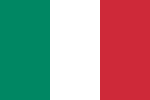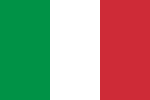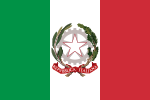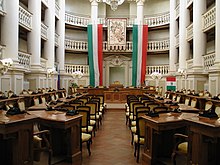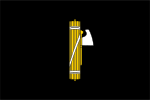Flag of italy
| Flag of italy | |
|---|---|
 |
|
| Vexillological symbol : |
|
| Aspect ratio: | 2: 3 |
| Officially accepted: | June 19, 1946, modified on July 28, 2006 |
The flag of Italy ( Italian Bandiera d'Italia , officially: Bandiera della Repubblica Italiana , il tricolore italiano ) is the most important state symbol of the Italian Republic . The Italian national flag is a tricolor with three vertical stripes in green, white and red. It has been in use since July 28, 2006 in the form used today with precisely defined colors.
The history of the flag can be traced back to the 1790s as it is a modified French Revolution export. On January 7, 1797, the Cispadan Republic , a forerunner of the Napoleonic Kingdom of Italy (1805–1814) , officially adopted the flag in Reggio Emilia , at that time with horizontal stripes. Every year on January 7th, Italy celebrates the “ Tricolor Holiday” (Festa del Tricolore) .
Appearance and meaning

The appearance of the flag is laid down in Article 12 of the Italian Constitution of January 1, 1948:
“La bandiera della Repubblica è il tricolore italiano: verde, bianco e rosso, a tre bande verticali di eguali dimensioni.”
"The flag of the republic is the Italian tricolor: green, white and red, in three vertical stripes of equal dimensions."
The flag has an aspect ratio of 2: 3.
Until June 1946 the flag with the coat of arms of the Royal House of Savoy on the white median was in use. After the proclamation of the republic , the coat of arms was officially removed on June 19, 1946 and this new version was given constitutional status on January 1, 1948. In 2003, the colors were precisely defined by the Berlusconi government for the first time: Instead of the strong colors used to date, the green of the flag was now more lime green (18-5642TC), the white now slightly ivory (11-4201TC) and the red slightly paler (18-1660TC). Because of this definition, there was a flag dispute between the right-wing government and the left-wing opposition, which called this change a "color coup". Berlusconi later stated that the shades used were a "technical error".
On July 28, 2006, under the left-wing government of Romano Prodis , the colors were specified again according to the following color codes and redefined as green, white and scarlet:
| green | White | red | |
|---|---|---|---|
| Pantone | 17-6153 TCX (Fern Green) | 11-0601 TCX (Bright White) | 18-1662 TCX (Flame Scarlet) |
| CMYK | C: 100 M: 000 Y: 100 K: 000 | C: 000 M: 000 Y: 000 K: 005 | C: 000 M: 100 Y: 100 K: 000 |
| RGB | R: 000 G: 140 B: 069 | R: 244 G: 245 B: 240 | R: 205 G: 033 B: 042 |
| HEX | # 008C45 | # F4F5F0 | # CD212A |
Since the flag was created in Napoleonic Italy, it is basically based on the French revolutionary model . The fact that the Italian tricolor has a green instead of a blue stripe is probably due to the green uniforms of the Milanese city militia at the time, otherwise to the Milanese city colors red and white. In the course of time, some very imaginative interpretations came up with regard to the meaning of the colors: Even during the Napoleonic period, green was assigned the natural rights of equality and freedom. According to other attributions, the green stands for hope, white for faith and red for love ( Theological Virtues , 1 Cor 13:13 EU ). Today the view is widespread that green stands for nature and the landscape or the plains, white for the color of the glaciers in the Alps or the snow on the mountains and red for the blood that was shed in the Italian struggles for freedom and unification , or in general for those who fell in wars.
Special forms
Italy has not had an official flag that deviates from the national flag since 1946 . The colors of the troop flags correspond to the national flag, but measure 99 × 99 cm (aspect ratio 1: 1). There are special flags for sea vessels.
Flags at sea
The coat of arms of the four largest Italian maritime republics of the Middle Ages (and early modern times): Venice , Genoa , Pisa and Amalfi can be seen on the naval war flag and on the merchant flag . The winged lion of St. Mark holds a sword on the sea war flag, which is decorated with a Roman ship's crown , and a book on the trade flag. Authority boats carry a tricolor with the emblem of the republic on the median.
 ? Naval war flag of the Kriegsmarine ( Marina Militare )
? Naval war flag of the Kriegsmarine ( Marina Militare )
Gösch of the Navy
Presidential Standard
The standard of the President of the Italian Republic corresponded to the national flag from 1946 to 1965. Until 2000 the standard was blue, with the emblem of the republic in the middle. The currently used standard was introduced in 2000 by President Carlo Azeglio Ciampi , followed in 2001 for the former presidents . The President of the Senate has been holding a standard since 1986 as long as he takes on the duties of the head of state when he is unable to do so, for example in the event of illness or when traveling abroad.
history
The Italian states
Since the Middle Ages, many states in what is now Italy had been using flags, some of which are still in use today as regional flags. Well-known examples are the flag of Genoa with the red St. George's Cross on a white background and the flag of Venice with the winged St. Mark's Lion.
Predecessor and creation of the national flag
It is officially recorded that supporters of the French Revolution were seen in Genoa with green, white and red cockades on August 21, 1789 , mistakenly using green instead of blue. Is also shows that such rosettes in the fall of 1794 during an uprising against the Papal States in Bologna by the students Luigi Zamboni and Giovanni Battista De Rolandis were worn and may have had an influence on the choice of the colors of the flag. According to other sources, the green in that case was a matter of chance. During Napoleon Bonaparte's Italian campaign , many Italian Jacobins supported the revolutionary troops because they wanted to put an end to absolutism in the Italian states. Many cities and towns in Italy had the French tricolor hoisted in 1796 . In Milan in 1796 arose from the small urban militia only a " National Guard " and shortly after the Legion Lombarda , a military Association of Transpadane Republic of Napoleon, the first cohort at Milan on November 6 of that year, Cathedral Square , a green-white-red troops flag was . The reason for the color combination was, in addition to the French tricolor, the militia's green uniform since 1782 and the city colors of Milan: white and red. The three stripes of the flag were aligned vertically. It became a model in other Napoleonic subsidiary republics in Italy. The Cispadan Republic , created at the end of 1796 , also set up a legion, whose cohorts in turn received green-white-red flags; the “Italian national colors” (Art. 8) were already mentioned in the installation decree.
After the Cispadane Republic in the hall of the city council of Reggio Emilia at 27 December 1796 its constitution was adopted, the team advised in the row over the state symbols. At the suggestion of the deputy Giuseppe Compagnoni from Lugo on January 7th, 1797 at eleven o'clock the green-white-red tricolor was decided as the flag of the republic, but without specifying the vertical or horizontal orientation of the stripes; the de facto decision was then made for the horizontal one. For the first time, this tricolor became a state symbol. For this reason, January 7th is a national day of remembrance in Italy, which is celebrated in the City Council Chamber of Reggio Emilia, called Sala del Tricolore .
The green-white-red tricolor (with vertical alignment of the stripes) was adopted by the Cisalpine Republic in 1797 . Both the Italian Republic of Napoleon, established in 1802, and the Napoleonic Kingdom of Italy, which existed until 1814, continued to use the colors green, white and red, but in a different order; the standard used by the Italian President today is based on that pattern.
After the Napoleonic era, the green-white-red tricolor as a state symbol disappeared again, but it remained a symbol of resistance against the Restoration and, above all, the symbol of the Italian unification movement . In the course of the Italian Wars of Independence , the tricolor was taken up again in 1848 by the Kingdom of Sardinia-Piedmont , which had placed itself at the forefront of the Italian unification movement. The tricolor as the national flag was added in the middle, vertical white stripe, the coat of arms of the Royal House of Savoy , which had been in the upper left corner of the blue flag of Sardinia-Piedmont before 1848. This blue of the Savoy lives on today in the jerseys of Italian national teams and in the blue sashes of Italian officers.
Based on the pattern of the tricolor with the Savoy cross, similar tricolors with the respective national or city coats of arms on the white median were created during the Italian unification process around 1848 and around 1860 in other Italian states. In 1861 the tricolor with the coat of arms of the Savoy national flag of the Kingdom of Italy, which emerged from Sardinia-Piedmont, became . On June 19, 1946, shortly after the proclamation of the republic, the coat of arms was removed from the flag. However, since it was feared that it would be confused with the flag of Mexico , whose trade flag at the time did not have a coat of arms on the white stripe, on November 9, 1947, a coat of arms was reinserted in the naval war flag and in the sea trade flag.
 ? Flag of the Transpadani Republic (1796–1797)
? Flag of the Transpadani Republic (1796–1797)
 Flag of the Cispadani Republic (1796–1797)
Flag of the Cispadani Republic (1796–1797)
 Flag of the Cisalpine Republic (1797–1802)
Flag of the Cisalpine Republic (1797–1802)
 Flag of the Kingdom of Italy under Napoleon (1805-1814)
Flag of the Kingdom of Italy under Napoleon (1805-1814)
 Flag of the Kingdom of Sardinia-Piedmont (1848–1861) and the Kingdom of Italy (1861–1946)
Flag of the Kingdom of Sardinia-Piedmont (1848–1861) and the Kingdom of Italy (1861–1946)
 Flag of the Roman Republic (1849)
Flag of the Roman Republic (1849)

 ? Official flag of the Kingdom of Italy (1861-1946)
? Official flag of the Kingdom of Italy (1861-1946)
 The “black flag of fascism ” was hoisted together with the national flag in 1926–1943.
The “black flag of fascism ” was hoisted together with the national flag in 1926–1943.
 War flag of the Italian Social Republic (1943–1945)
War flag of the Italian Social Republic (1943–1945)
 Flag of the Comitato di Liberazione Nazionale , a resistance movement against Italian fascism (1943–1947)
Flag of the Comitato di Liberazione Nazionale , a resistance movement against Italian fascism (1943–1947)
Museums
In Reggio Emilia, the Museo del Tricolore is located in the town hall next to the hall of the city council (Sala del Tricolore) . Troop flags of disbanded military units and naval flags of decommissioned warships are on display in the Vittoriano in Rome (Sacrario delle Bandiere) .
Flag rules
The legal basis is Act No. 22 of February 5, 1998 and, as an implementing provision, the Decree of the President of the Republic No. 121 of April 7, 2000. The flag of Italy and the European flag are placed in front of, on or in front of the offices of the constitutional bodies and ministries other authorities, the sub-national representatives of the people, the organs of the judiciary , the state schools and universities, the diplomatic and consular missions abroad, as well as in front of polling stations during the elections.

Special flagging days are:
- January 7th: Festa del Tricolore
- February 11: Lateran Treaties
- April 25: Liberation Day of Italy
- May 1st: Labor Day
- May 9: Europe Day
- June 2nd: Festa della Repubblica , national holiday
- September 28: Four days from Naples
- October 4th: St. Francis Day, St. Francis of Assisi , patron saint of Italy
- October 24th: United Nations Day
- November 4th: National Unity and Armed Forces Day , end of World War I in Italy
For special occasions, flags can be issued by the Prime Minister or, at local level, by the respective Prefect . The flag of Italy is hoisted first (in the places mentioned or elsewhere in Italy) and then lowered last, if there are two flags on the right-hand pole (as seen from the building), if there are three flags in the middle, unless the guest's flag is one EU state: then the European flag is in the middle and the Italian flag is on the left. If two flags are hoisted with three masts, the middle one remains without (not with standards). At the level of regional and local authorities, the sequence from right to left is: European flag, flag of Italy, (flag of the guest), flag (s) of the regional authority (s). The flag of Italy and the European flag (as well as the other flags mentioned, if applicable) are usually hoisted at sunrise and lowered at sunset, otherwise this takes place at the beginning and at the end of daily duty. At night they can only stay hoisted if they are lit. In the area of the military, the security authorities and the other regional authorities of Italy, there are supplementary flagging regulations, in other cases international flag law and the internationally customary flag etiquette apply . In Italy, too, denigrating national flags is a criminal offense .
See also
- Coat of arms of Italy
- Flags and coats of arms of the Italian regions
- Vatican City flag
- San Marino flag
Web links
- Flags of the World - Italy (English)
- quirinale.it - I Simboli della Repubblica - il Tricolore (Italian, English)
- Flag of Italy. In: Encyclopædia Britannica . Retrieved May 2, 2020 .
Individual evidence
- ↑ Italian constitution in Italian and German wording (PDF) Website of the Trentino-South Tyrol region (Italian)
- ↑ Italy . Flags of the World (English)
- ↑ Nicola Ferorelli: La vera origine del tricolore italiano . In: Rassegna storica del Risorgimento , vol. XII, fasc. III, 1925, p. 662 (Italian)
- ↑ Il significato dei colori della bandiera italiana on nanopress.it (Italian)
- ↑ Marco Poli: Brigida Borghi Zamboni, la madre dell'eroe. Per una rilettura del caso Zamboni-De Rolandis . In: Strenna storica bolognese , anno L, 2000, pp. 415–450 (Italian)
- ↑ Brief description of the history of the flag of Italy on the website of the Italian President
- ↑ Italy . Flags of the World (English)
- ↑ Official website of the municipal Museo del Tricolore (Italian)
- ↑ Legge 5 febbraio 1998 n.22 on camera.it (Italian)
- ↑ Decreto del Presidente della Repubblica 7 April 2000 n.121 on gazzettaufficiale.it (Italian)
- ↑ Art. 292, Art. 299 iStGB on parlamento.it (Italian)


